Foot swelling is a common problem for nurses and professionals who spend long hours on their feet during shifts. Standing or sitting for prolonged periods causes fluids to accumulate in the lower extremities, leading to uncomfortable swelling, stiffness, and pain.
Learning how to reduce foot swelling at work is essential not only for comfort but also for overall foot health and job performance. By managing swelling effectively, you can prevent further complications and enjoy more energy throughout your day.
Causes of Foot Swelling at Work
Foot swelling is a common problem for nurses and professionals who spend long hours on their feet. Several factors contribute to this discomfort:
- Prolonged Standing or Sitting:
Staying in the same position for hours at a time—whether standing or sitting—can slow down blood circulation. When blood flow slows, fluids tend to pool in the feet and ankles, causing noticeable swelling.
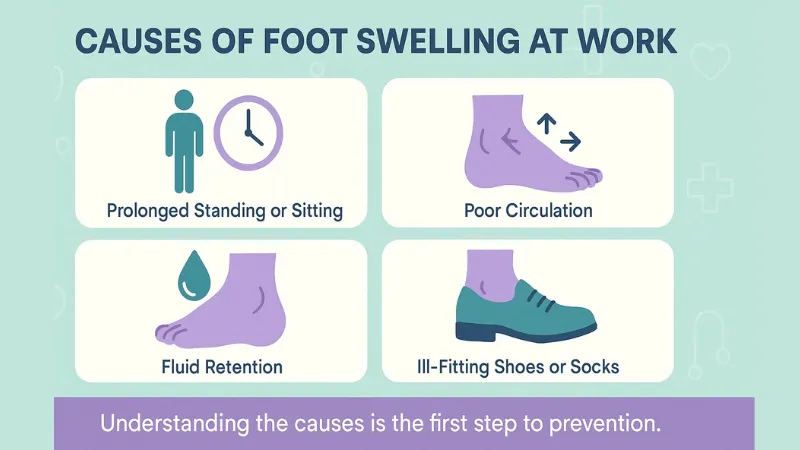
- Poor Circulation:
Certain health conditions or wearing shoes and socks that are too tight can restrict blood flow to your lower extremities. This limited circulation makes it harder for your body to move fluid out of your feet, leading to swelling and discomfort.
- Fluid Retention:
Your body’s tendency to hold onto excess fluids can be influenced by diet, medications, or hormonal changes. This retention can increase the amount of fluid collecting in your feet, especially after a long day on the job.
- Ill-Fitting Shoes or Socks:
Shoes or socks that squeeze your feet too tightly can compress blood vessels, further restricting circulation and causing swelling. Wearing footwear that doesn’t fit well adds unnecessary pressure, increasing the risk of swollen feet. That’s why you should get the best shoes for nurses.
Understanding these causes is crucial because it helps you take the right steps to prevent foot swelling and stay comfortable during long shifts.
Simple Ways to Reduce Foot Swelling at Work
Managing foot swelling during long shifts doesn’t have to be complicated. Here are some easy, practical tips to help keep your feet comfortable and reduce foot swelling at work throughout your workday:
- Elevate Your Feet During Breaks:
Whenever you get a chance, try to raise your feet above heart level. This simple position helps encourage fluid to flow back toward your heart, reducing the buildup in your feet and ankles.
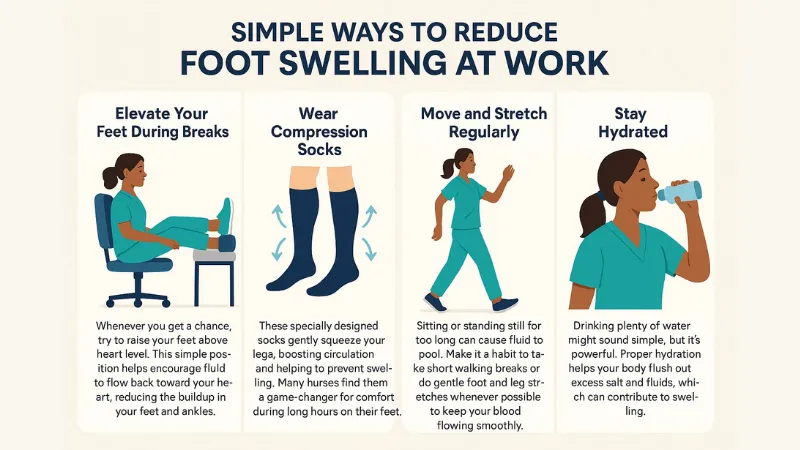
- Wear Compression Socks:
These specially designed socks gently squeeze your legs, boosting circulation and helping to prevent swelling. Many nurses find them a game-changer for comfort during long hours on their feet.
- Move and Stretch Regularly:
Sitting or standing still for too long can cause fluid to pool. Make it a habit to take short walking breaks or do gentle foot and leg stretches whenever possible to keep your blood flowing smoothly.
- Stay Hydrated:
Drinking plenty of water might sound simple, but it’s powerful. Proper hydration helps your body flush out excess salt and fluids, which can contribute to swelling.
By incorporating these habits into your daily routine, you can significantly reduce foot swelling at work and enjoy greater comfort throughout your workday.
Techniques to Improve Circulation in Your Feet
Good circulation is essential to prevent swelling at work or anywhere and keep your feet healthy, especially during long workdays. Here are some simple techniques you can easily do to boost blood flow:
- Foot Pumps and Ankle Rotations:
These easy exercises involve flexing and pointing your toes or rotating your ankles in circles. They help get the blood moving and reduce stiffness in your feet.
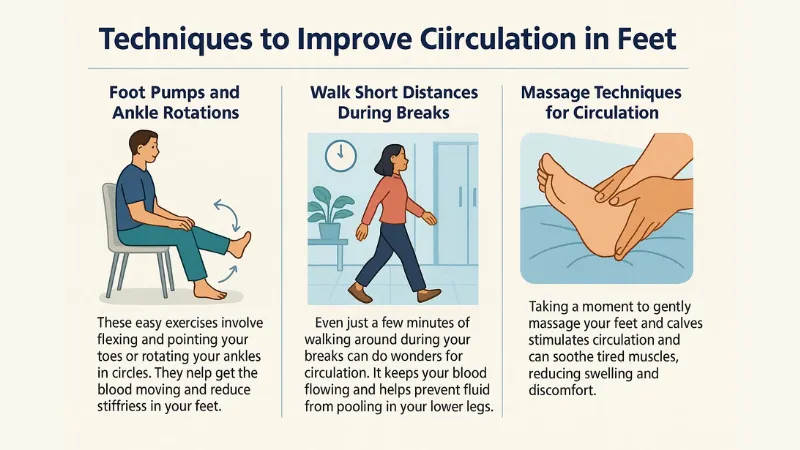
- Walk Short Distances During Breaks:
Even just a few minutes of walking around during your breaks can do wonders for circulation. It keeps your blood flowing and helps prevent fluid from pooling in your lower legs.
- Massage Techniques for Circulation:
Taking a moment to gently massage your feet and calves stimulates circulation and can soothe tired muscles, reducing swelling and discomfort.
These small actions are quick to do and can make a big difference in how your feet feel by the end of the day. If you’re wondering how to improve circulation in your feet, remember that regular movement is the key!
Relieving Tired Legs After Work
After spending long hours on your feet, your legs and feet often feel tired, heavy, and sometimes swollen. Taking time to care for them after your shift is crucial to help your body recover and prepare for the next day. Here are some effective and soothing methods to relieve tired legs after work:
Soak Feet in Warm Water:
A warm foot bath can work wonders for tired legs. The warmth helps relax tight muscles, increases blood circulation, and encourages fluid drainage, which reduces swelling. Adding Epsom salts or essential oils like lavender or peppermint to your foot soak can enhance relaxation and reduce inflammation. Aim for soaking your feet for about 15 to 20 minutes to get the maximum benefit.
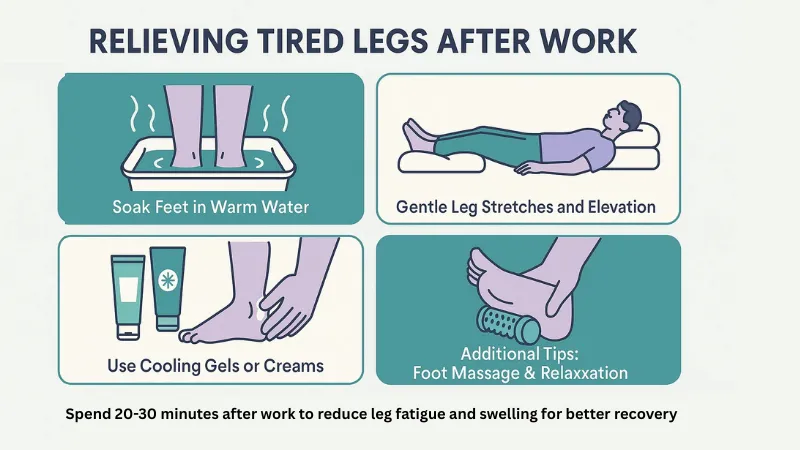
Gentle Leg Stretches and Elevation:
After your soak, performing gentle leg stretches can ease muscle tension and improve flexibility. Simple stretches like calf raises, ankle circles, or hamstring stretches are great options. Following stretching, elevate your legs above heart level—either by lying down and resting your legs on pillows or using a recliner. Elevation helps gravity move excess fluid away from your feet and ankles. This will reduce foot swelling at work and prevent that heavy, tired feeling.
Use Cooling Gels or Creams:
Applying cooling gels or creams infused with ingredients like menthol, arnica, or aloe vera can provide immediate relief and refreshment. These products not only soothe soreness and inflammation but also create a cooling sensation that helps numb discomfort. For extra care, gently massage the gel into your calves and feet, which also stimulates circulation and helps relax muscles.
Additional Tips:
- Wear loose, comfortable clothing after your shift to avoid restricting blood flow.
- Stay hydrated even after work to help your body flush out toxins and excess salt that contribute to swelling.
- Consider light foot massages or using a foot roller or massager to target pressure points and relieve tension.
By dedicating just 20-30 minutes after work to these recovery techniques, you can significantly reduce leg fatigue, prevent swelling, and promote overall foot health. Making these practices a routine part of your day helps you feel more energized, comfortable, and ready for the next shift
Foot Care Tips for Nurses
As a nurse, your feet are your foundation—supporting you through long shifts, quick movements, and constant standing. Taking care of your feet consistently is essential to reduce swelling at work, pain, and more serious foot problems down the line. Here are some key foot care tips every nurse should follow:
Proper Footwear Choices:
Investing in quality shoes is one of the best ways to protect your feet. That’s why choosing the right shoes is important for nurses. Look for shoes with strong arch support to distribute your weight evenly, ample cushioning to absorb shock, and a proper fit that allows your toes to move comfortably without slipping or pinching.
Avoid shoes that are too tight or loose, as either can cause blisters, calluses, or swelling. Many nurses prefer shoes specifically designed for healthcare professionals—they often feature breathable materials, slip resistance, and ergonomic designs.
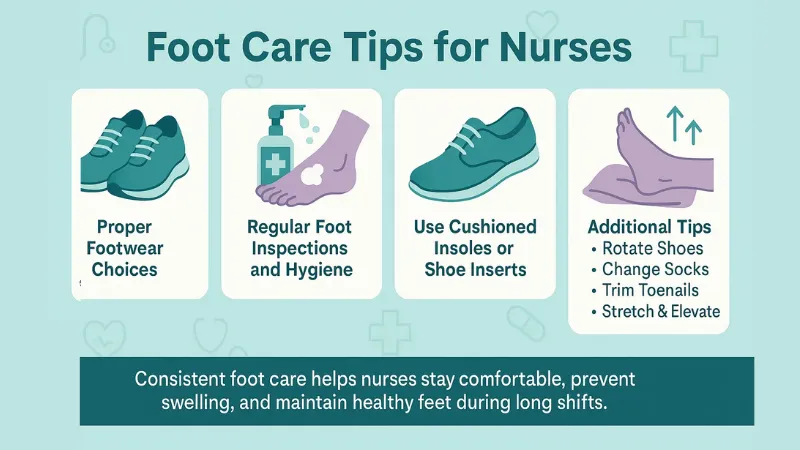
Regular Foot Inspections and Hygiene:
Make it a daily habit to inspect your feet closely. Look for any signs of swelling, redness, blisters, cuts, or unusual changes in skin texture. Early detection of problems can prevent more severe issues like infections or chronic pain.
Wash your feet thoroughly each day, paying special attention to the spaces between your toes, and dry them completely to avoid fungal infections. Using a mild soap and warm water, followed by moisturizing to prevent dryness and cracking, keeps your skin healthy and resilient.
Use Cushioned Insoles or Shoe Inserts:
Adding cushioned insoles or orthotic inserts to your shoes can provide an extra layer of comfort and support. These help reduce pressure on sensitive or swollen areas, absorb impact, and improve overall foot alignment. For nurses who stand or walk for hours, insoles designed with gel, memory foam, or specialized materials can significantly reduce fatigue and prevent the development of pain points.
Additional Tips:
- Rotate your shoes to allow each pair to air out and maintain their shape.
- Change socks during long shifts if they become damp or sweaty.
- Keep toenails trimmed straight across to avoid ingrown nails.
- Elevate your feet and do foot stretches regularly to promote circulation.
By incorporating these nurse foot care tips into your daily routine and understanding how to take care of your feet as a nurse, you’ll maintain stronger, healthier feet that can keep up with the demands of your job for years to come.
Standing Tips for Nurses to Prevent Swelling
Standing for long hours is a fundamental part of nursing, but it can take a serious toll on your feet and legs if not managed properly. To keep swelling at bay and maintain comfort throughout your shift, try incorporating these effective standing tips into your routine:
Shift Weight Frequently:
One of the simplest yet most effective ways to reduce foot and leg swelling is to avoid standing completely still for extended periods. Constant pressure on the same areas restricts blood flow and causes fluid to pool. Instead, subtly shift your weight from one foot to the other, or gently rock back and forth when possible.
These small movements encourage circulation and help prevent blood and fluids from accumulating in your lower extremities.
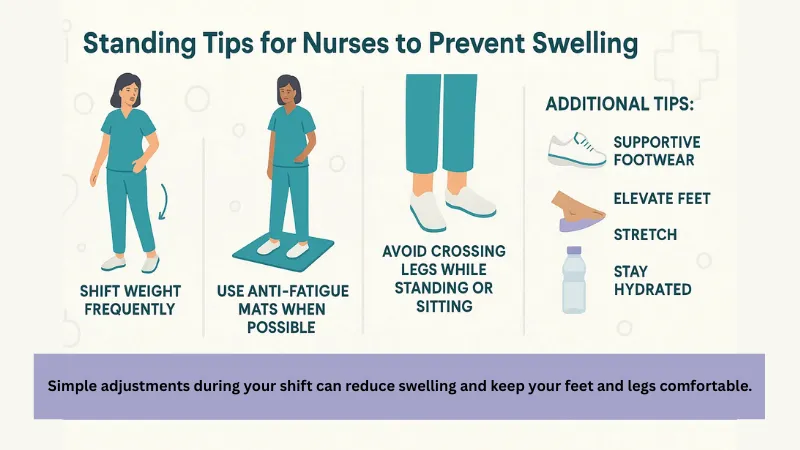
Use Anti-Fatigue Mats When Possible:
If your workplace allows it, standing on anti-fatigue mats can make a noticeable difference. These mats are designed with cushioning materials that absorb shock and reduce the strain on your feet, ankles, and legs. By providing a softer surface, they help alleviate pressure points and improve comfort, making those long shifts easier to endure.
Avoid Crossing Legs While Standing or Sitting:
Though it might feel natural to cross your legs, this position can actually restrict blood flow and contribute to swelling. When standing, keep your feet hip-width apart to maintain good balance and promote better circulation. While sitting during breaks, try to keep your legs uncrossed and elevate your feet when possible to help reduce fluid buildup.
Additional Tips for Better Standing Comfort:
- Wear properly fitting, supportive footwear designed for long hours on your feet.
- Take advantage of every break to sit down and elevate your feet.
- Incorporate gentle foot and calf stretches during brief pauses to stimulate circulation.
- Stay hydrated to help your body manage fluid balance effectively.
By following these standing tips for nurses, you can help your body cope better with the physical demands of your job, reduce swelling, and keep your feet and legs feeling healthier and more comfortable—even during the busiest shifts.
Lifestyle and Dietary Tips to Prevent Swelling
Managing foot swelling isn’t just about what you do at work—your daily habits outside of the workplace also play a big role. Making mindful lifestyle and dietary choices can help reduce swelling and support overall leg and foot health. Here are some key tips to consider:
Limit Salt Intake:
Too much salt in your diet causes your body to hold onto excess water, which can lead to swelling in your feet and ankles. Try to reduce processed and packaged foods, which often contain high amounts of hidden sodium.
Instead, focus on fresh fruits, vegetables, and whole foods that naturally have lower salt levels. Cooking meals at home also gives you more control over how much salt you use.
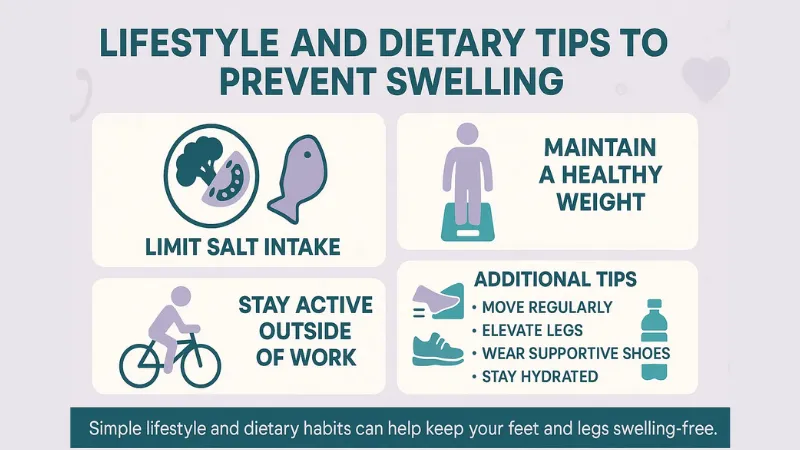
Maintain a Healthy Weight:
Carrying extra weight adds extra pressure on your legs and feet, making it harder for blood and fluids to circulate properly. Maintaining a healthy weight through balanced nutrition and regular exercise helps reduce this strain. Even a modest weight loss can have a positive impact on reducing swelling and improving your overall comfort during long shifts.
Stay Active Outside of Work:
Regular physical activity is one of the best ways to improve circulation throughout your body, including your feet and legs. Activities like walking, swimming, or cycling encourage blood flow and help prevent fluid buildup.
Consistency is key—try to get at least 30 minutes of moderate exercise most days of the week. This not only helps prevent swelling but also boosts your energy levels and overall health.
Additional Tips for Swelling Prevention:
- Avoid sitting or standing still for too long outside of work; keep moving throughout your day.
- Elevate your legs at home whenever you can to encourage fluid return.
- Wear comfortable shoes that provide proper support, even when you’re off-duty.
- Drink plenty of water—staying well-hydrated helps your body balance fluids better.
By adopting these simple lifestyle and dietary habits, you’re giving your feet and legs the best chance to stay healthy, comfortable, and swelling-free both on and off the job.
Recommended Products
Product | Speciality | |
Compression Socks | Improve Circulations and Reduce Swelling | |
Cushioned Insoles | Provides comfort and Reduces Pressure | |
Feet Cooling Sprays | Refresh and Reduce Inflammations | |
Foot Massager | Stimulates Blood Flow and Soothes Tired Feet |
Conclusion
It is essential to reduce foot swelling at work for comfort, health, and to maintain your energy during long shifts. By combining smart footwear choices, regular movement, proper foot care, and healthy lifestyle habits, nurses and professionals can enjoy less swelling and more comfort. Make these tips part of your daily routine and take better care of your feet today.
FAQs
What helps reduce foot swelling at work during long shifts?
Elevating your feet, wearing compression socks, moving regularly, and staying hydrated are effective ways to reduce swelling.
How can nurses improve foot circulation at work?
Performing foot pumps, ankle rotations, short walks, and gentle foot massages can improve circulation during shifts.
Are compression socks effective for foot swelling?
Yes, compression socks help improve blood flow and prevent fluid buildup in the feet and legs.
What are the best ways to relieve tired legs after work?
Soaking feet in warm water, elevating legs, gentle stretching, and using cooling gels help relieve tired legs.
How can standing nurses prevent swollen feet?
Shifting weight, using anti-fatigue mats, wearing proper footwear, and avoiding crossing legs can prevent swelling.

Leave a Reply